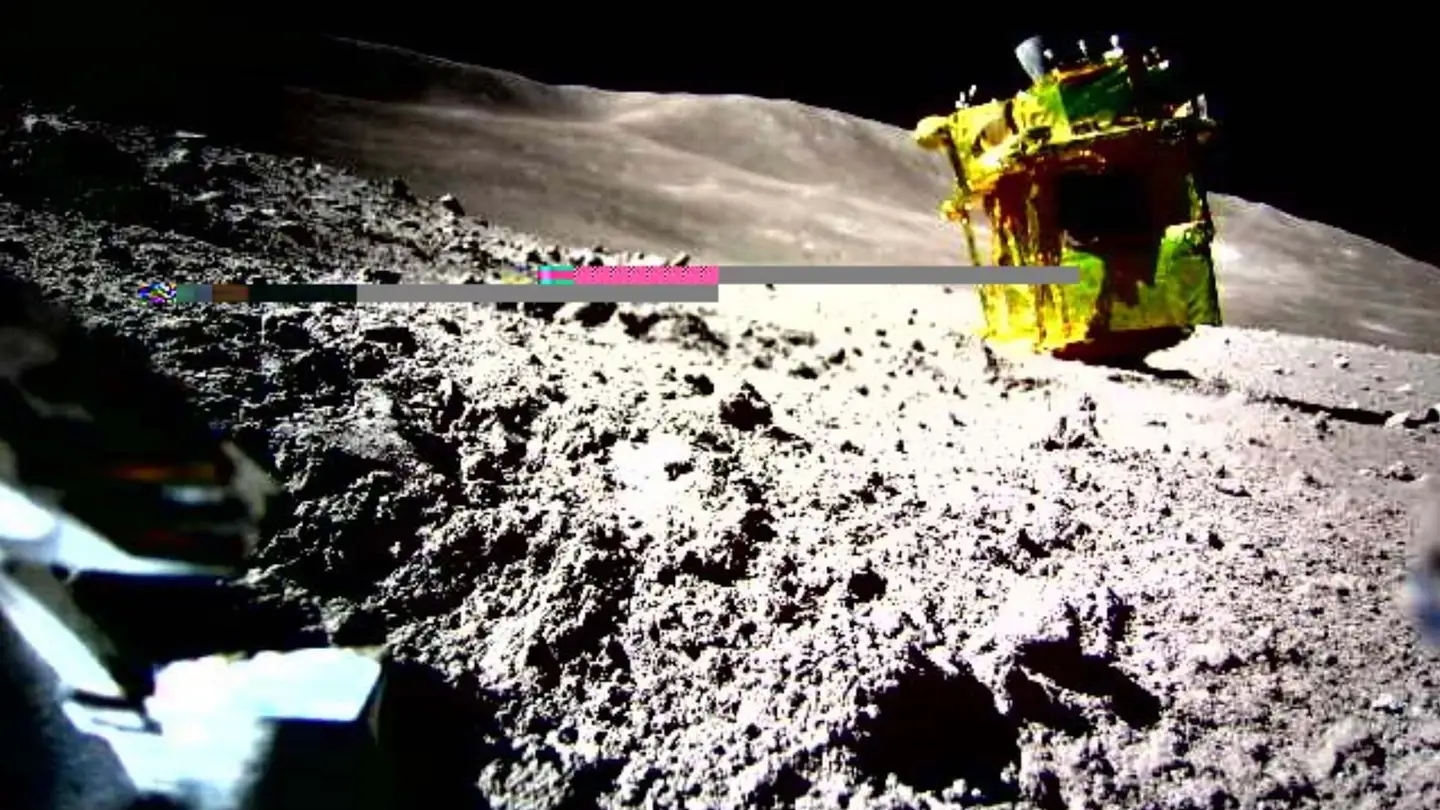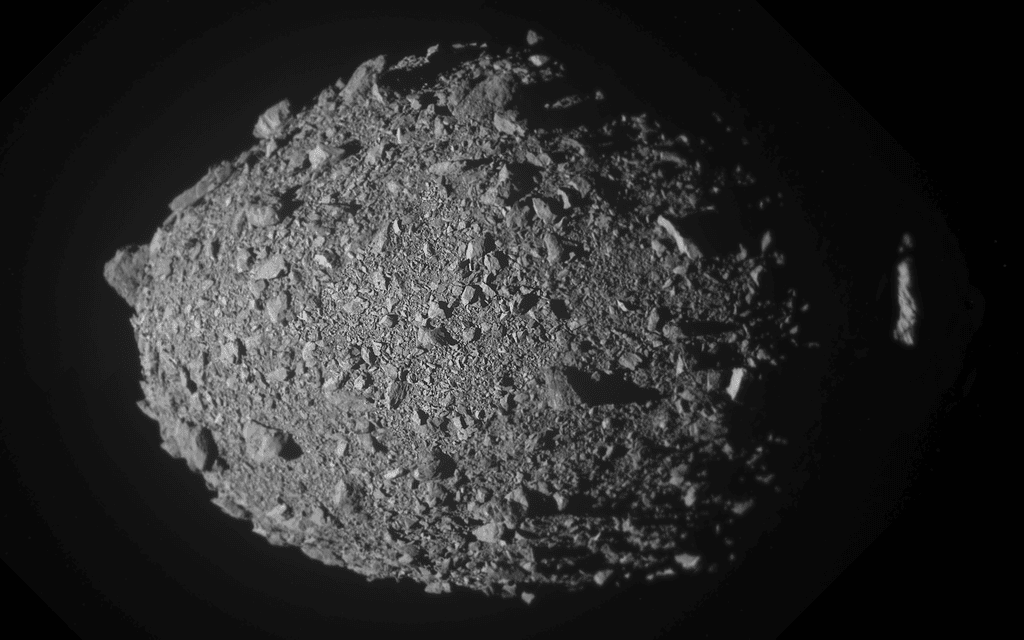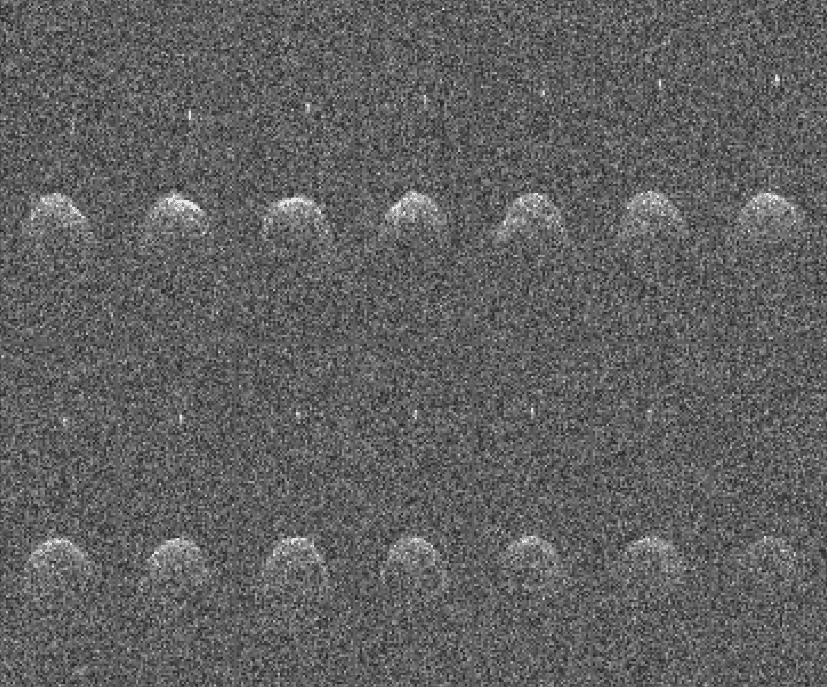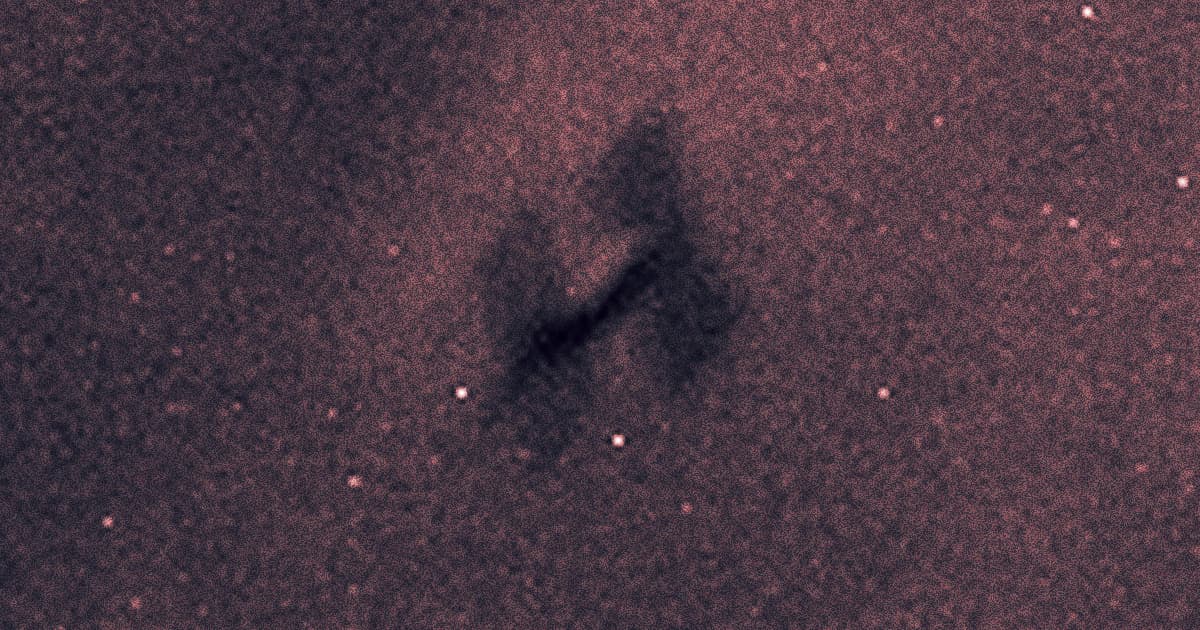SPACE
The historic moon lander beat the odds.
BY ANDREW PAUL | PUBLISHED FEB 26, 2024

Japan Aerospace Exploration Agency (JAXA) announced on Monday that its historic Smart Lander for Investigating Moon has defied the odds—after surviving a brutal, two-week lunar night while upside down, SLIM’s solar cells subsequently gathered enough energy to restart the spacecraft over the weekend. In an early morning post to X, JAXA reported it briefly established a communication relay with its lunar lander on Sunday, but the moon’s extremely high surface temperature currently prevents engineers from doing much else at the moment. Once SLIM’s instrument temperatures cool off in a few days’ time, however, JAXA intends to “resume operations” through additional scientific observations as long as possible.
[Related: This may be SLIM’s farewell transmission from the moon.]
SLIM arrived near the moon’s Shioli crater on January 19, making Japan the fifth nation to ever reach the lunar surface. Although JAXA’s lander successfully pulled off an extremely precise touchdown, it did so upside down after its main engines malfunctioned about 162-feet above the ground. The resulting nose-down angle meant SLIM’s solar cell arrays now face westward, thereby severely hindering its ability to gather power. Despite these problems, the craft’s two tiny robots still deployed and carried out their reconnaissance duties as hoped and snapped some images of the inverted lander. Meanwhile, SLIM transmitted its own geological survey data back to Earth for a few precious hours before shutting down.
Although JAXA officials cautioned that might be it for their lander, SLIM defied the odds and rebooted 10 days later with enough juice to continue surveying its lunar surroundings, such as identifying and measuring nearby rock formations.
“Based on the large amount of data obtained, analysis is now underway to identify rocks and estimate the chemical composition of minerals, which will help to solve the mysteries surrounding the origin of the Moon. The scientific results will be announced as soon as they are obtained,” JAXA said at the time.
But by February 1, the moon’s roughly 14.5-day lunar night was setting in, plunging temperatures down to a potentially SLIM-killing -208 Fahrenheit. Once again, JAXA bid a preemptive farewell to their plucky, inverted technological achievement—only to be surprised yet again over the weekend.
In the few days since the most recent lunar evening’s conclusion, SLIM apparently recharged its solar cells enough to come back online. But as frigid as the moon’s night phases are, its daytime temperatures can be just as brutal. According to JAXA, some of the lander’s equipment initially warmed up to over 212-degrees Fahrenheit. To play it safe, mission control is giving things a little time to cool off before tasking SLIM with additional scans, such as using its Multi-Band Camera to assess nearby regolith formations’ chemical compositions.
JAXA has a few more days before the moon enters another two-week night, during which SLIM will go into yet another hibernation. While it could easily succumb to the lunar elements this next time, it’s already proven far more resilient than its designers thought possible. It may not surpass expectations as dramatically as NASA’s Mars Ingenuity rotocopter (RIP), but the fact that SLIM made it this long is cause enough for celebration.
In the process of proving we could deflect asteroids we also learned quite a bit about them
by Mihai Andrei
February 26, 2024
Edited and reviewed by Zoe Gordon

Dimorphos, a potato-shaped moonlet orbiting the larger asteroid Didymos, was virtually unknown to most people until recently. But on September 26th, 2022, it became the stage for a historic event: the first deliberate planetary defense mission, NASA’s Double Asteroid Redirection Test (DART).
DART was a daring initiative to assess humanity’s ability to prevent a catastrophic asteroid collision. The idea was to target Dimorphos and change its moonlet’s orbit through a direct kinetic impact. The successful mission marked a historic moment. It demonstrated for the first time that human ingenuity could indeed modify the path of celestial objects.
But this was just one aspect of the mission. DART is not just about testing our ability to deflect potentially Earth-threatening asteroids. It’s also about exploring asteroids and the birth of our solar system.
Dimorphos is weak
The DART mission deflected the moonlet Dimorphos by directly colliding with it at high speed. This impact altered Dimorphos’s momentum, resulting in a change to its orbital path around its parent asteroid, Didymos.
As a result, NASA researchers were expecting DART to create a sizable crater. But the mission reshaped Dimorphos’s surface in unforeseen ways. The collision generated an ejecta curtain, propelling debris into space and altering the asteroid’s surface topography. This phenomenon provided critical data on the asteroid’s structural integrity and the dynamics of ejecta in microgravity environments, offering new perspectives on asteroid material composition and behavior.
Sabina Raducan and her team used advanced shock physics simulations, guided by initial DART mission findings, to study the impact on Dimorphos. Their models, which closely matched the actual impact observations, indicate that Dimorphos is a weak asteroid, with surface characteristics similar to other asteroids.
The simulations suggest Dimorphos is a “rubble-pile” asteroid, a type characterized by a loose collection of rocks bound by weak gravitational forces. Surprisingly, the mission uncovered that Dimorphos’s cohesive strength was much lower than anticipated, and its bulk density was comparable to other well-studied asteroids like Ryugu and Bennu. These findings suggest that despite their varied appearances and orbits, these space rocks share common origins or formation processes.

The findings, once more, are important on two fronts. Firstly, they suggest that many asteroids may have formed in the same way and may be structurally weak.
This paves the way for more effective defensive mechanisms against potential asteroid threats — which may just prove to be useful in the future. Enriching our understanding of our solar system is, at the same time, making us a bit safer in the solar system.
The study was published in Nature Astronomy.
Astronomers detect an extremely red supermassive black hole in the early universe growing in the shadows
Mass is much higher than expected
BEER-SHEVA, Israel, February 28, 2024 – Analyzing images from the James Webb Space Telescope (JWST), a group of astronomers led by Dr. Lukas Furtak and Prof. Adi Zitrin from Ben-Gurion University of the Negev has detected an extremely red, gravitationally lensed supermassive black-hole in the early Universe. Its colors suggest that the black hole lies behind a thick veil of dust obscuring much of its light. The team managed to measure the black hole mass and discovered that it was significantly more massive, compared to its host galaxy, than what has been seen in more local examples. The finding was published in Nature two weeks ago.
The JWST, launched two years ago, has revolutionized our view of early galaxy formation. It has led to the detection of very early galaxies in greater abundances and greater brightnesses than previously predicted, and revealed some new types of objects.
The group of astronomers had detected in JWST images what seemed to be a lensed, quasar-like object from the early universe. Quasars are bright active galactic nuclei: supermassive black holes in the centers of galaxies that are actively accreting material.
The accretion of material onto the black hole emits copious amounts of radiation that overshine the host galaxy, leading to a compact and bright, star-like appearance. The JWST images in which Furtak and Zitrin identified the object were taken for the UNCOVER program (PIs: Ivo Labbé, from Swinburne University of Technology, and Rachel Bezanson from the University of Pittsburgh), which imaged the field of a cluster of galaxies, Abell 2744, to an unprecedented depth. Since the cluster contains large amounts of mass it bends spacetime -- or the paths of light rays traveling near it -- effectively creating a gravitational lens. The gravitational lens magnifies the background galaxies behind it and allows astronomers to observe even more distant galaxies than otherwise possible.
"We were very excited when JWST started sending its first data. We were scanning the data that arrived for the UNCOVER program and three very compact yet red-blooming objects prominently stood out and caught our eyes," says Dr. Lukas Furtak, a postdoctoral researcher at BGU and the lead author of the discovery papers. "Their “red-dot” appearance immediately led us to suspect that it was a quasar-like object".
Furtak and the UNCOVER group started investigating the object. “We used a numerical lensing model that we had constructed for the galaxy cluster to determine that the three red dots had to be multiple images of the same background source, seen when the Universe was only some 700 million years old”, says Prof. Zitrin, an astronomer at BGU and one of the lead authors of the discovery papers.
"Analysis of the object's colors indicated that it was not a typical star-forming galaxy. This further supported the supermassive blackhole hypothesis", says Prof. Rachel Bezanson, from University of Pittsburgh and co-lead of the UNCOVER program. "Together with its compact size, it became evident this was likely a supermassive black hole, although it was still different from other quasars found at those early times", Prof. Bezanson added. The discovery of the uniquely red and compact object was published last year in the Astrophysical Journal. But that was just the beginning of the story.
The team then acquired JWST/NIRSpec data of the three images of the “red dot” and analyzed the data. "The spectra were just mind blowing", says Prof. Ivo Labbé, from Swinburne University of Technology and co-lead of the UNCOVER program, "By combining the signal from the three images together with the lensing magnification, the resulting spectrum is equivalent to ~1700 observing hours by JWST on an unlensed object, making it the deepest spectrum JWST has obtained for a single object in the early universe," says Prof. Labbé.
"Using the spectra, we managed to not only confirm that the red compact object was a supermassive black hole and measure its exact redshift, but also obtain a solid estimate for its mass from the width of its emission lines", says lead author Dr. Furtak. "Gas is orbiting in the gravitational field of the black hole and achieves very high velocities that are not seen in other parts of galaxies. Because of the Doppler shift, light emitted by the accreting material is red-shifted on one side and blue-shifted on the other side, according to its velocity. This causes emission lines in the spectrum to become broader."
But the measurement led to yet another surprise, published in Nature two weeks ago: the black-hole's mass seems to be excessively high compared to the host galaxy's mass.
"All the light of that galaxy must fit within a tiny region the size of a present-day star-cluster. The gravitational lensing magnification of the source gave us exquisite limits on the size. Even packing all the possible stars into such a small region, the black hole ends up being at least 1% of the total mass of the system,” says Prof. Jenny Greene from Princeton University and one of the lead authors of the recent paper. "In fact, several other supermassive black-holes in the early Universe have now been found to show a similar behavior, which lead to some intriguing views of black hole and host galaxy growth, and the interplay between them, which is not well understood."
Astronomers do not know if such supermassive black-holes grow, for example, from stellar remnants, or perhaps from material that directly collapsed into black holes in the early Universe.
"In a way, it's the astrophysical equivalent of the chicken and egg problem", says Prof. Zitrin. “We do not currently know which came first – the galaxy or black hole, how massive the first black holes were, and how they grew."
Since many more such “little red dots” and other active galactic nuclei have recently been detected with JWST, hopefully, we will have a better idea soon.
JOURNAL
Nature
METHOD OF RESEARCH
Observational study
ARTICLE TITLE
A high black hole to host mass ratio in a lensed AGN in the early Universe
Metal scar found on cannibal star
Peer-Reviewed PublicationIMAGE:
THIS ARTIST’S IMPRESSION SHOWS THE MAGNETIC WHITE DWARF WD 0816-310, WHERE ASTRONOMERS HAVE FOUND A SCAR IMPRINTED ON ITS SURFACE AS A RESULT OF HAVING INGESTED PLANETARY DEBRIS.
WHEN OBJECTS LIKE PLANETS OR ASTEROIDS APPROACH THE WHITE DWARF THEY GET DISRUPTED, FORMING A DEBRIS DISC AROUND THE DEAD STAR. SOME OF THIS MATERIAL CAN BE DEVOURED BY THE DWARF, LEAVING TRACES OF CERTAIN CHEMICAL ELEMENTS ON ITS SURFACE.
USING ESO’S VERY LARGE TELESCOPE, ASTRONOMERS FOUND THAT THE SIGNATURE OF THESE CHEMICAL ELEMENTS CHANGED PERIODICALLY AS THE STAR ROTATED, AS DID THE MAGNETIC FIELD. THIS INDICATES THAT THE MAGNETIC FIELDS FUNNELED THESE ELEMENTS ONTO THE STAR, CONCENTRATING THEM AT THE MAGNETIC POLES AND FORMING THE SCAR SEEN HERE.
view moreCREDIT: ESO/L. CALÇADA
When a star like our Sun reaches the end of its life, it can ingest the surrounding planets and asteroids that were born with it. Now, using the European Southern Observatory’s Very Large Telescope (ESO’s VLT) in Chile, researchers have found a unique signature of this process for the first time — a scar imprinted on the surface of a white dwarf star. The results are published today in The Astrophysical Journal Letters.
“It is well known that some white dwarfs — slowly cooling embers of stars like our Sun — are cannibalising pieces of their planetary systems. Now we have discovered that the star’s magnetic field plays a key role in this process, resulting in a scar on the white dwarf’s surface,” says Stefano Bagnulo, an astronomer at Armagh Observatory and Planetarium in Northern Ireland, UK, and lead author of the study.
The scar the team observed is a concentration of metals imprinted on the surface of the white dwarf WD 0816-310, the Earth-sized remnant of a star similar to, but somewhat larger than, our Sun. “We have demonstrated that these metals originate from a planetary fragment as large as or possibly larger than Vesta, which is about 500 kilometres across and the second-largest asteroid in the Solar System,” says Jay Farihi, a professor at University College London, UK, and co-author on the study.
The observations also provided clues to how the star got its metal scar. The team noticed that the strength of the metal detection changed as the star rotated, suggesting that the metals are concentrated on a specific area on the white dwarf’s surface, rather than smoothly spread across it. They also found that these changes were synchronised with changes in the white dwarf’s magnetic field, indicating that this metal scar is located on one of its magnetic poles. Put together, these clues indicate that the magnetic field funneled metals onto the star, creating the scar [1].
“Surprisingly, the material was not evenly mixed over the surface of the star, as predicted by theory. Instead, this scar is a concentrated patch of planetary material, held in place by the same magnetic field that has guided the infalling fragments,” says co-author John Landstreet, a professor at Western University, Canada, who is also affiliated with the Armagh Observatory and Planetarium. “Nothing like this has been seen before.”
To reach these conclusions, the team used a ‘Swiss-army knife’ instrument on the VLT called FORS2, which allowed them to detect the metal scar and connect it to the star’s magnetic field. “ESO has the unique combination of capabilities needed to observe faint objects such as white dwarfs, and sensitively measure stellar magnetic fields,” says Bagnulo. In their study, the team also relied on archival data from the VLT’s X-shooter instrument to confirm their findings.
Harnessing the power of observations like these, astronomers can reveal the bulk composition of exoplanets, planets orbiting other stars outside the Solar System. This unique study also shows how planetary systems can remain dynamically active, even after 'death'.
Notes
[1] Previously, astronomers have observed numerous white dwarfs polluted by metals that were scattered over the surface of the star. These are known to originate from disrupted planets or asteroids that veer too close to the star, following star-grazing orbits similar to those of comets in our Solar System. However, for WD 0816-310, the team is confident that vaporised material was ionised and guided onto the magnetic poles by the white dwarf's magnetic field. The process shares similarities to how auroras form on Earth and on Jupiter.
More information
This research was presented in a paper titled “Discovery of magnetically guided metal accretion onto a polluted white dwarf” to appear in The Astrophysical Journal Letters (doi:10.3847/2041-8213/ad2619).
The team is composed of Stefano Bagnulo (Armagh Observatory & Planetarium, UK [Armagh]), Jay Farihi (Department of Physics and Astronomy, University College London, UK), John D. Landstreet (Armagh; Department of Physics & Astronomy, Western University, Canada), and Colin P. Folsom (Tartu Observatory, University of Tartu, Estonia).
The European Southern Observatory (ESO) enables scientists worldwide to discover the secrets of the Universe for the benefit of all. We design, build and operate world-class observatories on the ground — which astronomers use to tackle exciting questions and spread the fascination of astronomy — and promote international collaboration for astronomy. Established as an intergovernmental organisation in 1962, today ESO is supported by 16 Member States (Austria, Belgium, Czechia, Denmark, France, Finland, Germany, Ireland, Italy, the Netherlands, Poland, Portugal, Spain, Sweden, Switzerland and the United Kingdom), along with the host state of Chile and with Australia as a Strategic Partner. ESO’s headquarters and its visitor centre and planetarium, the ESO Supernova, are located close to Munich in Germany, while the Chilean Atacama Desert, a marvellous place with unique conditions to observe the sky, hosts our telescopes. ESO operates three observing sites: La Silla, Paranal and Chajnantor. At Paranal, ESO operates the Very Large Telescope and its Very Large Telescope Interferometer, as well as survey telescopes such as VISTA. Also at Paranal ESO will host and operate the Cherenkov Telescope Array South, the world’s largest and most sensitive gamma-ray observatory. Together with international partners, ESO operates ALMA on Chajnantor, a facility that observes the skies in the millimetre and submillimetre range. At Cerro Armazones, near Paranal, we are building “the world’s biggest eye on the sky” — ESO’s Extremely Large Telescope. From our offices in Santiago, Chile we support our operations in the country and engage with Chilean partners and society.
Links
- Research paper
- Photos of the VLT
- For journalists: subscribe to receive our releases under embargo in your language
- For scientists: got a story? Pitch your research
JOURNAL
The Astrophysical Journal Letters

ESA VIA X / FUTURISM
by FRANK LANDY
Fiery Demise
After almost three decades in orbit, a large satellite called ERS-2 came barreling back down to Earth on Wednesday, finally meeting its end by burning up in our atmosphere. Safe to say that the old codger went out in a blaze of glory — and thankfully, we've got photos documenting its epic final moments.
Those photos, released earlier this week, come courtesy of the European Space Agency (ESA), and were captured by cameras on board nearby satellites operated by Australian space company HEO.
Taken between mid-January and early February, they depict ERS-2 plunging down to our atmosphere a few weeks before re-entering it. Note that it's a long journey, and the spacecraft was still some 180 miles above Earth. But at a pace of some six miles per day, it wouldn't be long before it inevitably reached our atmosphere.
As many have observed, the grainy images make it strongly resemble a TIE Fighter from "Star Wars," perhaps in pursuit of some meddling rebel hiding out on Earth.
Climate Pioneer
ERS-2 was decommissioned in 2011, and has spent the better part of the years that followed slowly de-orbiting to make room for other satellites.
Launched in 1995, in its heyday it was the "most sophisticated Earth observation spacecraft ever developed and launched by Europe," the ESA said, gathering critical data on our planet's climate, and specifically its ozone layer.
With its advanced capabilities, ERS-2 also helped scientists understand the severity of global warming and climate change, such as revealing that the Earth's ice sheets, once believed to be stable, were actually melting at a rapid pace.
The satellite was still functioning when it was decommissioned over a decade ago, but it was decided that its remaining fuel should be used to push itself down out of its orbit. By the time it neared our atmosphere, no fuel was remaining, and so its re-entry was uncontrolled.
On Wednesday, it finally came hurtling through the atmosphere. Most if not all of it would disintegrate and burn up due to the immense drag, with any errant debris falling into the ocean. And thus marked the end of a beloved satellite, cremated in the coolest way possible.
"Goodnight everyone. Goodnight ERS-2," ESA Operations said on X, formerly Twitter.

No comments:
Post a Comment